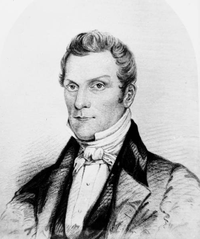Hyrum Smith
Hyrum Smith ( February 9, 1800 , † June 27, 1844 ) was an American church leader in the Church of Christ . He was the older brother of the founder of Mormonism , Joseph Smith . He was murdered with his brother while they were both waiting for a trial.
Early life
Hyrum was born in Tunbridge . He was the second son of Joseph Smith, Sr. and Lucy Mack Smith . Smith was poorly trained and therefore became a farmer. He was at Dartmouth College in his teens. This was one of the reasons why Dr. Nathan Smith treated his brother Joseph's leg.
Church service
Smith was a close advisor and confidante to his brother Joseph during the translation of the Book of Mormon and the establishment of the Church of Christ . In June 1829, Smith was baptized in Seneca Lake . He was one of the Eight Witnesses who saw and touched the gold plates . He even saw the angel Moroni once. When the Church of Christ was organized, on April 6, 1830, Hyrum Smith signed its founding charter with five other men. At the age of thirty, Hyrum was the oldest of the six men. Smith became a branch president in Colesville and was one of the first missionaries in the area.
As the Church and its members moved west, Smith and his family also moved. In 1831 he built a house in Kirtland . During his time there, he worked in the quarry to provide stone for the construction of the Kirtland Temple . Between 1831 and 1833 he served as a missionary in Missouri and Ohio . In 1834 he recruited members for a militarist unit on his brother's behalf. With this they tried to help the Mormons in Missouri. He was chosen to serve as a second counselor in the First Presidency in 1837. From 1838–39, he and his brother shared a prison cell with three other Church leaders. They were waiting for a trial.
After moving to Nauvoo , Hyrum became the Supreme Patriarch . A position that only his father Joseph Smith, Sr. held. He also replaced Oliver Cowdery as Assistant President of the Church . With that calling, Smith served as his brother's representative in the Church should he be prevented or perish. He was given this position in the Church even though he was not ordained to the priesthood of the Apostle .
When they were in danger, his brother Joseph told him to flee to Cincinnati . Smith refused. He went to Carthage, Illinois , with his brother . There she awaits a trial for insurrection and treason. On June 27, 1844, the prison was attacked by a mob of about 260 men. When the brothers tried to barricade themselves, both were shot.
Because of his position as Assistant President of the Church , Hyrum would have replaced his brother if he had survived.
Women and children
On November 2, 1826, he married Jerusha Barden (1805-1837). They had six children together.
- Lovina Smith (September 16, 1827 - October 8, 1876), who married Lorin Walker
- Mary Smith (June 27, 1829 - May 29, 1832)
- John Smith (September 22, 1832 - November 6, 1911)
- Hyrum Smith (April 27, 1834 - September 21, 1841)
- Jerusha Smith (January 13, 1836 - June 27, 1912)
- Sarah Smith (October 2, 1837 - November 6, 1876), who married Charles Emerson Griffin
On December 24, 1837, he married Mary Fielding Smith (1801-1852). They had two children.
- Joseph F. Smith (November 13, 1838 - November 19, 1918)
- Martha Ann Smith (May 14, 1841 - October 19, 1923)
In August 1843 he married two women: Mercy Fielding Thompson and Catherine Phillips.
progeny
The descendants of Hyrum played important roles in The Church of Jesus Christ of Latter-day Saints . His son Joseph F. Smith served as President of the Church from 1901 to 1918. His grandson Joseph Fielding Smith served as President from 1970 to 1972. The current Apostle M. Russell Ballard is also a direct descendant of Smith. His descendants also held the title of Supreme Patriarch . They kept this until 1978, when this title was abolished in the LDS Church. In 1918, Smith's descendants erected a memorial to him in Salt Lake City Cemetery.
Individual evidence
- ↑ KJZZ Joseph Smith Papers interview with Leroy Wirthlin and Ron Esplin
- ↑ Tom Pettit: Moroni Appeared to 17 Different People! . In: Living Heritage Tours . Retrieved April 24, 2016.
- ^ Gary James Bergera, "Hyrum Smith" in W. Paul Reeve and Ardis E. Parshall (eds.), Mormonism: A Historical Encyclopedia (Santa Barbara, California, ABC-Clio, 2010) pp. 182–84 at 183. "his appointment as assistant president may have included such authority"
- ^ Joseph Smith: Documentary History of the Church , Volume 6. Deseret Book Company, https://byustudies.byu.edu/content/volume-6-chapter-34 , p. 617.
- ^ Doctrine and Covenants, section 135
- ↑ Ryan C. Jenkins: The Assassination of Joseph Smith . Cedar Fort ,, ISBN 9781462124497 (Retrieved July 24, 2017).
- ↑ Sherise G. Clayton: SARAH SMITH GRIFFIN . Retrieved July 24, 2017.
- ↑ Linda King Newell , Valeen Tippetts Avery : Mormon Enigma: Emma Hale Smith , 2nd. Edition, University of Illinois Press , Urbana and Chicago 1994, ISBN 0-252-06291-4 , p. 142.
credentials
- James B. Allen and Glen M. Leonard: The Story of the Latter-day Saints . Deseret Book Company, 1976, ISBN 0-87747-594-6 .
- Daniel H. Ludlow: Church History, Selections from the Encyclopedia of Mormonism . Deseret Book Company, 1992, ISBN 0-87579-924-8 .
- Jeffrey S. O'Driscoll: Hyrum Smith: A Life of Integrity . Deseret Book Company, 2003, ISBN 1-57008-857-8 .
Further literature
Web links
| personal data | |
|---|---|
| SURNAME | Smith, Hyrum |
| BRIEF DESCRIPTION | Brother of the Mormon Prophet Joseph Smith |
| DATE OF BIRTH | February 9, 1800 |
| DATE OF DEATH | June 27, 1844 |

